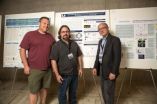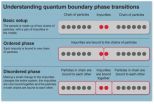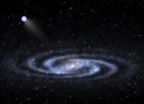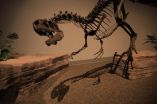(Press-News.org) University of Houston physicists have discovered a new thermoelectric material offering high performance at temperatures ranging from room temperature up to 300 degrees Celsius, or about 573 degrees Fahrenheit.
"This new material is better than the traditional material, Bismuth telluride, and can be used for waste heat conversion into electricity much more efficiently," said Zhifeng Ren, M.D. Anderson Chair professor of physics at UH and the lead author of a paper describing the discovery, published online by Nano Energy.
Ren, who is also principal investigator at the Texas Center for Superconductivity at UH, said the work could be important for clean energy research and commercialization at temperatures of about 300 degrees Celsius.
Bismuth telluride has been the standard thermoelectric material since the 1950s and is used primarily for cooling, although it can also be used at temperatures up to 250 C, or 482 F, for power generation, with limited efficiency.
For this discovery, Ren and other members of his lab used a combination of magnesium, silver and antimony to generate electricity from heat using the thermoelectric principle. They added a small amount of nickel, after which Ren said the compound worked even better.
The work was done in collaboration with researchers from the UH Department of Chemistry and the Massachusetts Institute of Technology. Huaizhou Zhao and Jiehe Sui, a member of Ren's lab whose home institute is the Harbin Institute of Technology in China, were primary contributors; Zhao is now a research scientist at the Institute of Physics with the Chinese Academy of Sciences.
The material works well up to 300 C, Ren said; work to improve its efficiency is ongoing.
The potential for capturing heat – from power plants, industrial smokestacks and even vehicle tailpipes – and converting it into electricity is huge, allowing heat that is currently wasted to be used to generate power. Ren said temperatures there can range from 200 C to 1,000 C, and until now, there hasn't been a thermoelectric material capable of working once conditions get beyond the lower levels of heat. Much of the demand ranges from 250 C to 300 C, he said.
Ren long has worked in thermoelectrics, among other scientific fields. His research group published an article in the journal Science in 2008 establishing that the efficiency – the technical term is the "figure of merit" – of Bismuth telluride could be increased as much as 20 percent by changing how it is processed. At the time, Ren was at Boston College.
And his lab last summer published a paper in the Proceedings of the National Academy of Sciences establishing tin telluride with the addition of the chemical element indium as a material capable of converting waste heat to electricity. But tin telluride works best at temperatures higher than about 300 C, or about 573 F, making it important to continue looking for another material that works at lower temperatures.
Ren's group isn't the first to study the new material, which has not been named but is referred to in the Nano Energy paper as simply MgAgSb-based materials, using the chemical names for the elements used to create it. The paper cites work done in 2012 by M.J. Kirkham, et al; that work used magnesium, silver and antimony in equal parts, Ren said, but resulted in impurities and poor conducting properties.
He said his lab found that using slightly less silver and antimony, and mixing the elements separately – putting magnesium and silver first in the ball milling process, adding the antimony after several hours – eliminated the impurities and significantly improved the thermoelectric properties.
"We had much different qualities," he said. "Better, with no impurities, and smaller grain size, along with much better thermoelectric properties."
INFORMATION: END
Discovery offers new possibilities for clean energy research
UH researchers find new high-efficiency thermoelectric material
2014-05-07
ELSE PRESS RELEASES FROM THIS DATE:
Ability to isolate and grow breast tissue stem cells could speed cancer research
2014-05-07
LA JOLLA—By carefully controlling the levels of two proteins, researchers at the Salk Institute have discovered how to keep mammary stem cells—those that can form breast tissue—alive and functioning in the lab. The new ability to propagate mammary stem cells is allowing them to study both breast development and the formation of breast cancers.
"What we've shown is that we can take these cells out of a mouse and study them and regulate them in the laboratory by providing them with a specific factor," says Peter C. Gray, a staff scientist in Salk's Clayton Foundation ...
Today's offenders are tomorrow's victims in gangs
2014-05-07
HUNTSVILLE, TX (5/7/14) -- Gang members are twice as likely to become both a victim and an offender of a crime than non-gang members, as single acts of violence often lead to retribution between gangs as a whole, according to a new study.
"In other words, gang members are not distinctly offenders or victims; instead, gang membership is a common source of both forms of violence," said David Pyrooz, an assistant professor at Sam Houston State University, College of Criminal Justice and principal author of the study. "Today's criminal offender is tomorrow's victim, and today's ...
Arctic study sheds light on tree-ring divergence problem
2014-05-07
SAN FRANCISCO -- Changes in tree-ring density in the Arctic may be evidence of changes in light intensity during the trees' growth, according to a new study by San Francisco State University researcher Alexander Stine.
The finding has direct implications for the tree-ring "divergence problem," a phenomenon that has received considerable media attention but has been widely misinterpreted, said Stine, an assistant professor of Earth & climate sciences.
Tree rings consist of a low density ring, which forms early in the growing season, and a high density ring that forms ...
Newly found dinosaur is long-nosed cousin of Tyrannosaurus rex
2014-05-07
Scientists have discovered a new species of long-snouted tyrannosaur, nicknamed Pinocchio rex, which stalked the Earth more than 66 million years ago.
Researchers say the animal, which belonged to the same dinosaur family as Tyrannosaurus rex, was a fearsome carnivore that lived in Asia during the late Cretaceous period.
The newly found ancient predator looked very different from most other tyrannosaurs. It had an elongated skull and long, narrow teeth compared with the deeper, more powerful jaws and thick teeth of a conventional T. rex.
Palaeontologists were uncertain ...
Melting an entire iceberg with a hot poker: Spotting phase changes triggered by impurities
2014-05-07
"What a curious feeling," says Alice in Lewis Carroll's tale, as she shrinks to a fraction of her size, and everything around her suddenly looks totally unfamiliar. Scientists too have to get used to these curious feelings when they examine matter on tiny scales and at low temperatures: all the behaviour we are used to seeing around us is turned on its head.
In research published today in the journal Nature Communications, UCL scientists have made a startling discovery about a familiar physical effect in this unfamiliar setting.
Phase transitions are a category of ...
Sprites form at plasma irregularities in the lower ionosphere
2014-05-07
Atmospheric sprites have been known for nearly a century, but their origins were a mystery. Now, a team of researchers has evidence that sprites form at plasma irregularities and may be useful in remote sensing of the lower ionosphere.
"We are trying to understand the origins of this phenomenon," said Victor Pasko, professor of electrical engineering, Penn State. "We would like to know how sprites are initiated and how they develop."
Sprites are an optical phenomenon that occur above thunderstorms in the D region of the ionosphere, the area of the atmosphere just above ...
International molecular screening program for metastatic breast cancer AURORA at IMPAKT
2014-05-07
While research has made great strides in recent decades to improve and significantly extend the lives of patients with early breast cancer, the needs of patients with advanced or metastatic disease have largely been ignored. Moreover, despite the fact that the overall breast cancer death rate has dropped steadily over the last decade and significant improvements in survival have been made, metastatic breast cancer represents the leading cause of death among patients with the disease.
In this context the Breast International Group (BIG) recently launched AURORA, which ...
Nearest bright 'hypervelocity star' found
2014-05-07
SALT LAKE CITY, May 7, 2014 – A University of Utah-led team discovered a "hypervelocity star" that is the closest, second-brightest and among the largest of 20 found so far. Speeding at more than 1 million mph, the star may provide clues about the supermassive black hole at the center of our Milky Way and the halo of mysterious "dark matter" surrounding the galaxy, astronomers say.
"The hypervelocity star tells us a lot about our galaxy – especially its center and the dark matter halo," says Zheng Zheng, an assistant professor of physics and astronomy and lead author ...
All teeth and claws? New study sheds light on dinosaur claw function
2014-05-07
Theropod dinosaurs, a group which includes such famous species as Tyrannosaurus rex and Velociraptor, are often regarded as carnivorous and predatory animals, using their sharp teeth and claws to capture and dispatch prey. However, a detailed look at the claws on their forelimbs revealed that the form and shape of theropod claws are highly variable and might also have been used for other tasks.
Inspired by this broad spectrum of claw morphologies, Dr Stephan Lautenschlager from Bristol's School of Earth Sciences studied the differences in claw shape and how these are ...
Revealing the healing of Dino-sores
2014-05-07
Scientists have used state-of-the-art imaging techniques to examine the cracks, fractures and breaks in the bones of a 150 million-year-old predatory dinosaur.
The University of Manchester researchers say their groundbreaking work – using synchrotron-imaging techniques – sheds new light, literally, on the healing process that took place when these magnificent animals were still alive.
The research, published in the Royal Society journal Interface, took advantage of the fact that dinosaur bones occasionally preserve evidence of trauma, sickness and the subsequent signs ...
LAST 30 PRESS RELEASES:
Global first: New Indigenous-led research initiative to revitalize legal orders
Transforming acoustic waves with a chip
When climate risk hits home, people listen: Study reveals key to engagement with disaster preparedness messaging
Major breakthrough against diabetes thanks to a microbial molecule that disarms inflammation
Silicon chips on the brain: Researchers announce a new generation of brain-computer interface
Getting rest is the best
Towards sustainable organic synthesis – Mechanochemistry replaces lithium with sodium in organic reactions
Wireless device ‘speaks’ to the brain with light
Greenhouse gases to intensify extreme flooding in the Central Himalayas
New study sheds light on Milky Way's mysterious chemical history
Could altering the daily timing of immunotherapy improve survival in people with cancer?
Weaving secondary battery electrodes with fibers and tying them like ropes for both durability and performance
Using social media may impair children’s attention
Science briefing: An update on GLP-1 drugs for obesity
Lower doses of immunotherapy for skin cancer give better results
Why didn’t the senior citizen cross the road? Slower crossings may help people with reduced mobility
ASH 2025: Study suggests that a virtual program focusing on diet and exercise can help reduce side effects of lymphoma treatment
A sound defense: Noisy pupae puff away potential predators
Azacitidine–venetoclax combination outperforms standard care in acute myeloid leukemia patients eligible for intensive chemotherapy
Adding epcoritamab to standard second-line therapy improves follicular lymphoma outcomes
New findings support a chemo-free approach for treating Ph+ ALL
Non-covalent btki pirtobrutinib shows promise as frontline therapy for CLL/SLL
University of Cincinnati experts present research at annual hematology event
ASH 2025: Antibody therapy eradicates traces of multiple myeloma in preliminary trial
ASH 2025: AI uncovers how DNA architecture failures trigger blood cancer
ASH 2025: New study shows that patients can safely receive stem cell transplants from mismatched, unrelated donors
Protective regimen allows successful stem cell transplant even without close genetic match between donor and recipient
Continuous and fixed-duration treatments result in similar outcomes for CLL
Measurable residual disease shows strong potential as an early indicator of survival in patients with acute myeloid leukemia
Chemotherapy and radiation are comparable as pre-transplant conditioning for patients with b-acute lymphoblastic leukemia who have no measurable residual disease
[Press-News.org] Discovery offers new possibilities for clean energy researchUH researchers find new high-efficiency thermoelectric material




